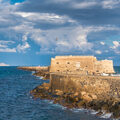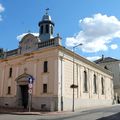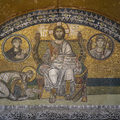I am starting a new series on our blog in which I make interviews with foreign researchers and creators related to historical topics. Since their audience mainly does not know Hungarian, while our common audience speaks Hungarian, I decided to present the questions and the answers in both languages - English and Hungarian.I hope you will welcome this initiation. Our goal is to show, that in contrast to the famous saying of Mór Jókai ("Extra Hungarian non est vita, si est vita, non est ita" - "Outside of Hungary there is no life, if there is life, it is not the same.") there is life outside of Hungary. In the first part of the series, I talked with Daniel, the founder of the Eastern Roman History YouTube channel. Daniel currently runs one of the largest channels related to Byzantine history, he has more than 20.000 subscribers and his community is very active, including running a Discord server. I am publishing the interview in my own Hungarian translation in addition to the English original.
Blogunkon új sorozatot indítok, melynek keretében külföldi kutatókkal, alkotókkal készítek interjúkat. Mivel az ő közönségük döntően nem tud magyarul, a mi közösnégünk viszont magyar nyelvű, úgy döntöttem mindkét nyelven - angolul és magyarul - közlöm a kérdéseket és az azokra adott válaszokat. Remélem jól fogadjátok ezen kezdeményezést. Célunk bemutatni, hogy Jókai Mór híres mondásával szemben ("Extra Hungarian non est vita, si est vita, non est ita" - "Magyarországon kívül nincs élet, ha van élet, nem olyan.") igenis van élet Magyarországon kívül. A sorozat első részében az Eastern Roman History nevű YouTube csatorna megálmodójával, Daniellel beszélgettem. Daniel jelenleg az egyik legnagyobb, bizánci történelemmel kapcsolatos csatornát vezeti, több mint 20 ezer feliratkozóval rendelkezik és közössége igen aktív, többek között Discord szervert is üzemeltet. Az interjút az angol eredeti mellett a saját magyar fordításban közlöm.
- How did you become interested in history? Is it rooted in your childhood - like in my case - or did it become a more serious interest later?
Hogyan kezdtél el érdeklődni a történelem iránt? A gyerekkorodban gyökerezik ez - mint az én esetemben -, vagy később vált komolyabb érdeklődéssé?
I became interested in history from quite an early age. I was fascinated by Ancient Egypt, it was something so alien but also, to put it rather glibly, rather cool as well to have towering obelisks and pyramids, with these wonderfully painted figures from 1000's of years ago. It was a subject that kept drawing me in. The more I learned, the more I wanted to learn. It was not until my mid-teens that I actually became interested the Byzantines. That was a process begun by my existing interest in the Roman Empire and the late Antique period. The appreciation of the importance of history is something else that was impressed upon me from an early age. Back then I may well have struggled to put it into words, but there is a certain aura to history. It is not merely words on a page of a book, though that may well be the ultimate fate of some elements of history, but it is a testiment of what people chose to do in the fleeting time that was given to them and that is important in itself. In my own case, three of my ancesters fought in the First World War. Two of them never returned and they were the much beloved cousins of my father's grandmother. He remembers that whenever he met his gran and their memory was raised, that she would have a tear in her eye for them. My late Grandpa, had an amasing life and, early on, faced tragedy and persecution from National Socialist Germany, which murdered both of his parents. He came to Britain, served in the British army during the Second World War, came back, studied, got a job as an engineer and eventually became his company director. He fell in love with my grandma at first sight, raised a family, whom raised their families and had careers of their own and along I eventually came. That great thing is I know them all very well and that is something I will never forget. I myself, have had many personal adventures which I won't go into detail about. I remember the Great Recession in 2008. I watched one of the runners take the Olympic flame to the stadium in 2012. I voted in the In/Out vote over the EU in 2016. I had to rough it indoors with COVID-19 and most recently, I watched the coronation of HM king Charles III, the first British coronation of the twenty-first century and the first British king to be crowned in 70 years. History was also a subject that has great significance in my family. My great-grandfather, F. Gordon Roe was himself an art historian and geanologist. Both my late Grandma and Grandpa were very interested in history as are my parents, so history, you could say, is something that runs in the family.
Már igen korán elkezdett érdekelni a történelem. Lenyűgözött az ókori Egyiptom, valahogy idegen, ugyanakkor – hogy lazábban fogalmazzak – inkább menő volt, hogy vannak toronymagas obeliszkek és piramisok gyönyörű festett figurákkal több ezer évvel ezelőttről. Ez egy olyan téma volt, ami folyamatosan bevonzott. Minnél többet tanultam, annál többet akartam tanulni. Csak tizenéves korom közepétől kezdtem el érdeklődni a bizánciak iránt. Ez a folyamat a Római Birodalom és a kései antikvitás iránti eredeti érdeklődésemből fakadt. A történelem fontosságának elismerése olyan valami, ami már kicsi koromtól kezdve erős hatással volt rám. Még akkor talán keményen küszködtem volna, hogy ezt megfogalmazzam, de van a történelemnem egyfajta aurája. Nem csak egyszerűen szavak egy könyv lapján – habár a történelem egyes részeinek ez lehet a végső sorsa – hanem tanúsága azon cselekedeteknek, melyeket az emberek választanak a nekik adott elröppenő/múlandó időben és ez önmagában fontos. Az én esetemben három ősöm is harcolt az I. világháborúban. Közülük ketten – akik az édesapám nagymamájának oly nagyon szeretett unokatestvérei voltak - sosem tértek vissza. Édesapám emlékei szerint bármikor, amikor találkozott a nagymamájával és felderengett az emlékük, mindig megjelent a szemében értük egy könnycsepp. Néhai nagyapámnak bámulatos élete volt és ideje korán szembenézett a nemzetiszocialista Németország tragédiájával és üldözésével, amely mindkét szülőjét meggyilkolta. Britanniába jött, a II. világháború idején a brit hadseregben szolgált, visszatért, tanult, mérnökként munkát szerzett és végül a saját cégének vezetője lett. Első látásra beleszeretett nagymamámba, családot alapított, akik megalapították a saját családjaikat és lett saját karrierjük és ennek mentén jöttem végül én. Nagyszerű dolog, hogy mindnyájukat nagyon jól ismerem és ez olyan dolog, amit sohasem fogok elfelejteni. Nekem személy szerint rengeteg kalandom volt, amelyekről nem fogok részletesebben beszélni. Emlékszem a 2008-as nagy gazdasági világválságra. Néztem, ahogy az egyik futó az olimpiai lángot a stadionba vitte 2012-ben. Szavaztam az EU-ból ki/EU-ban bent szavazáson 2016-ban. Otthon kellett megküzdenem a COVID-19-cel és legutóbb megtekintettem Őfelsége, III. Károly király koronázását, a XXI. század első brit koronázását, 70 év után az első megkoronázott királyt. A történelem ezenfelül egy olyan tárgy volt, amelynek nagy jelentősége volt a családomban. Dédapám, F. Gordon Roe maga is művészettörténész és genealógus volt. Mind néhai nagymamám, mind néha nagyapám nagyon érdeklődött a történelem iránt, ahogy a szüleim is, szóval a történelem – mondhatnád – egy olyan dolog, ami „családi vonás”.
- As far as I know, you started your YouTube channel called Eastern Roman History about 5 years ago. What made you decide to start a YouTube channel?
Ha jól tudom nagyjából 5 éve indítottad el YouTube-csatornádat, amely Eastern Roman History néven fut. Mi miatt döntöttél egy YouTube-csatorna elindítása mellett?
In July 2018, I uploaded 6 videos over a short period to provide the bedrock of what would become Eastern Roman History. I conceived the idea of creating a YouTube channel earlier that year, which was the final year of my undergraduate degree at King's College London. Something I noted was that information about the Byzantines on the internet was often cursory and drawn from the same few general histories, such as John Julius Norwich, Warren Treadgold and George Ostrogorsky. If one compares the Wikipedia entry for a Byzantine emperor and a Roman emperor like Hadrian, the former reads like a short newspaper article and the latter is, often, very detailed and informative for the medium it is on. The same was true for YouTube at the time, you had fantastic videos on subjects like the First World War and Alexander the Great but the Byzantine Empire was hardly covered at all at that point. I recall a video by Knowledgia that made an overview video of Byzantine history and a third of it was spent of Justinian I. Moreover, and I do not wish to sound provocative, but some of the videos that had covered Byzantine history were quite amateurish. Not so much in the production values but the actual history itself. No use of primary sources, no discussion of historiographical debates and with that no citation of where the information for this was coming from. For a History student where these practices are my bread and butter I considered this to be a niche that I could fill. Making a YouTube video was not something so alien to me. My brother has made several videos on YouTube and so the process was already mapped out. I waited until I finished my final year and then spent June setting up my channel and these 6 videos and voila! Eastern Roman History was born.
2018 júliusában 6 videót töltöttem fel rövid idő alatt, hogy megteremtsem az alapkövét annak, ami Eastern Roman History néven megszületett. A YouTube-csatorna indítás ötlete már korábban megfogant bennem abban az évben, ami egyben az utolsó évem volt egyetemi hallgatóként a King’s College London kötelékében. Észrevettem, hogy a bizánciakkal kapcsolatos információk az interneten általában felületesek voltak és ugyanazon néhány általános történeti áttekintésből származtak, mint John Julius Norwich, Warren Treadgold és Georg Ostrogorsky. Ha valaki összehasonlítja egy bizánci császár és egy római császár, mint Hadrianus Wikipédia-szócikkét, az előbbi egy rövid újságcikkhez hasonlít, míg az utóbbi – gyakran – nagyon kidolgozott és informatív ahhoz a felülethez képest, melyen megjelenik. Abban az időben ugyanez volt igaz a YouTube-ra, fantasztikus videókat találtál az I. világháborúról vagy Nagy Sándorról, de a Bizánci Birodalom korántsem volt tárgyalva. Emlékszem a Knowledgia egyik videójára, amely egy áttekintést adott a bizánci történelemről és közel harmada I. Jusztinianosszal foglalkozott. Továbbá, és nem akarok provokatív lenni, de néhány videó, amely a bizánci történelemmel foglalkozott, nagyon amatőr volt. Nem is a produkció minőségében, inkább magában a „történelem” tekintetében. Nem használtak elsődleges forrásokat, nem tárgyaltak különféle kutatástörténeti vitákat, ráadásul az információk forrását sem jelölték meg. Nekem, mint történész hallgatónak, akinek ezek a dolgok a „mindennapi kenyeret” jelentik, úgy tűnt ez egy rés, amit be tudnék tölteni. A YouTube-videó készítés nem volt nagyon idegen a számomra. Testvérem számos videót készített YouTube-ra, így a folyamat már fel volt térképezve. Megvártam, míg befejezem az utolsó évemet és ezt követően a júniust a csatornám felállításával és a 6 videó elkészítésével töltöttem és voilá!, megszületett az Eastern Roman History.
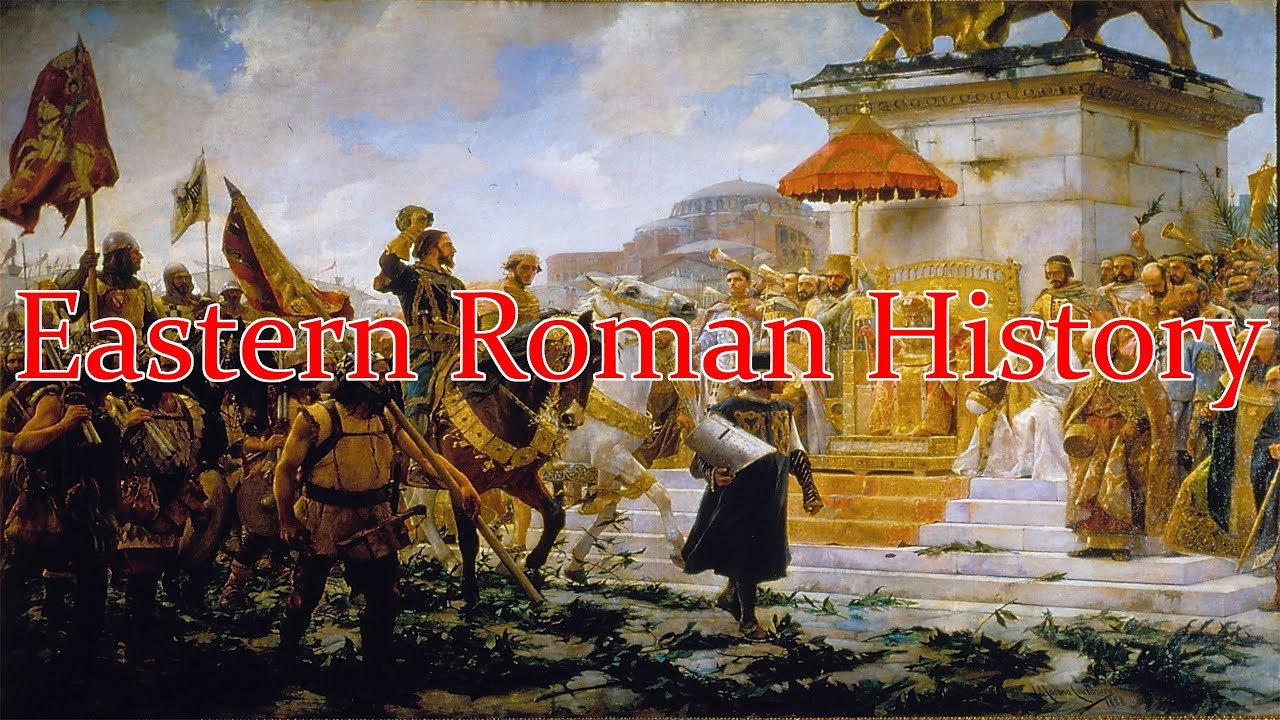
- Weren't you afraid that the topic would not have an audience? Did you expect that so many people will follow you and because of this a community will form as a result of your work?
Nem féltél attól, hogy nem lesz közönsége a témának? Számítottál arra, hogy ennyien fognak téged követni és kialakul egy közösség a munkásságod nyomán?
No, I had no fear of a lack of an audience. In other media, it seemed clear that the Byzantines were starting to have a larger profile amongst a general audience. In terms of the success of my channel, frankly I did not know what to expect. I am very happy to see that Eastern Roman History has been and continues to be successful and growing and that people like the detailed and, hopefully engaging content I make.
Nem, nem féltem a hallgatóság hiányától. Más médiafelületeken egyértelműnek tűnt, hogy a bizánciak kezdenek nagyobb érdeklődésre szert tenni az általános közönség körében. A csatornám sikere kapcsán őszintén nem tudtam mit várjak. Nagyon örülök, hogy az Eastern Roman History sikeres és növekvő tudott és tud lenni és hogy az emberek szeretik azt a részletes és – reményeim szerint – érdekfeszítő tartalmat, amit gyártok.
- What is your main motivation for making various, very detailed and informative videos about Byzantine history constantly?
Mi a fő motivációd, ami miatt folyamatosan készíted a különféle, igencsak részletes és informatív videókat a bizánci történelemről?
My motivations can vary regarding the topics I choose for a video. Firstly, there does need to be a base of sources to work from. Sometimes people ask questions like, 'and what was happening in this place' or 'What about a detailed history of X, Y and Z.' or something and I can only do that if there are the sources to do so. My video on Sardinia and Theodoro were full of narrative black holes because sometimes we just don't have the sources to fill in the gaps. Generally, I like to make videos on subjects that interest me or if I have been reading a particularly interesting article or book then I might turn that into a video idea. A great example is my video on the battle of Kleidion. Not only had I been wanting to make a video about it, but I had also been reading about the deeds of Theophylact and Michael Botaneiates and realised that in every history that covered the battle within the last thirty years, historians had played down the importance of the battle because it did not immediately end the Bulgarian war but none of them mentioned the victory the two Botaneiatai won at Thessalonica earlier the same month. Furthermore, what war was instantly ended by a single decisive battle? With the same logic we might say that the Battle of Hastings was an unimportant battle because the English did not immediately surrender to the Normans. So for me, this was chance to present my own conclusions and explore these historiographical arguements as well as the narrative itself.
A motivációim elég változékonyak, függően azon témáktól, amiket egy videóhoz kiválasztok. Először is, kell egy forrásalap, amelyekből lehet dolgozni. Néha olyasmit kérdeznek az emberek, hogy „és mi történt ezen a helyen?” vagy „Mi a helyzet X, Y, és Z részletes történetével?”, vagy valami hasonló és ezeket csak akkor tudom megcsinálni, ha vannak források. A Szardíniáról vagy a Theodóroi Fejedelemségről szóló videóim tele voltak narratív szempontból fekete lyukakkal, mert néha nincsenek meg a forrásaink, hogy kitöltsük a réseket. Általánosságban véve olyan témákról szeretek videókat készíteni, amelyek engem érdekelnek vagy ha olvastam egy különösképpen érdekes cikket vagy könyvet, akkor azt lehet átalakítom egy videóötletté. A kleidioni csatáról szóló videóm egy nagyon jó példa. Nem csak hogy akartam róla készíteni egy videót, hanem olvastam is Theophülaktosz és Mikhaél Botaneiatész cselekedeteiről és rájöttem, hogy minden olyan történeti irodalom esetében, amely foglalkozott a csatával az utóbbi harminc évben, a történészek lebecsülték a csata jelentőségét, mert az nem fejezte be azonnal a bolgárokkal vívott háborút. Viszont egyikük sem említette a két Botaneiatész ugyanabban a hónapban korábban aratott győzelmét Thesszalonikánál. Továbbá, melyik háború ért véget egyből egyetlen döntő ütközettel? Ugyanezzel a logikával azt mondhatnánk, hogy a hastings-i csata lényegtelen volt, mert az angolok nem adták meg magukat egyből a normannoknak. Tehát számomra ez egy lehetőség volt, hogy bemutassam a saját megállapításaimat és felfedezzem ezeket a kutatástörténeti vitákat, ahogy magát a narratívát is.
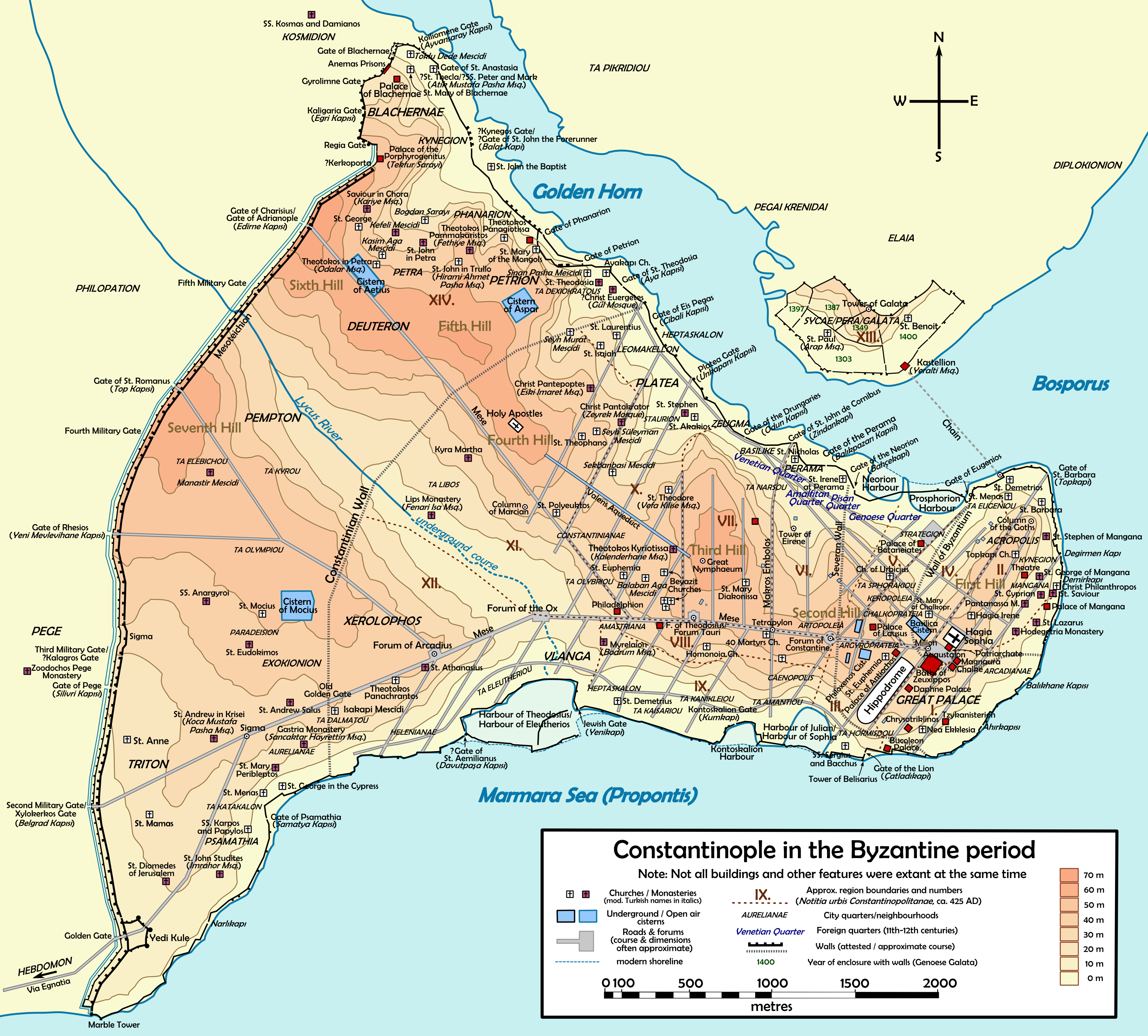
The city of Constantinople - Konstantinápoly városa
- How do you get from an idea to a finished video, what does an average creative process look like in your case?
Hogyan jutsz el egy ötlettől egy kész videóig, hogy néz ki a te esetedben egy átlagos alkotói folyamat?
Rather simply, I choose a topic, research and write a script, record it, edit the audio, edit the video effects and the other paraphernalia that goes with it and upload it to the internet.
Igen egyszerű, kiválasztom a témát, kutatok és megírom a szkriptet, felveszem, megszerkesztem a hangot, megszerkesztem a képi effekteket és más dolgokat, amik ehhez kapcsolódnak, majd feltöltöm az internetre.
- Are there any history-related YouTube channels whose content you watch often and whose work you find useful and valuable?
Vannak-e olyan, történelemmel foglalkozó YouTube-csatornák, melyeknek a tartalmait gyakran nézed és a munkásságát hasznosnak, illetve értékesnek tartod?
Yes, recently I have enjoyed Old Britannia, which covers eighteenth to nineteenth century history. I enjoy Epic History TV, History Marche and House of History, I think all three of them on the whole easily go toe-to-toe with television documentaries. For channels that cover Roman history I enjoy Romaboo Ramblings, Serapeium Historia and the SPQR Historian. Also Real Crusades History makes good content and completely revised my understanding or lack thereof of the Crusades. I also enjoyed Atun-shei Films and the Ministry for History for their similarly intriguing videos. There are several others I would like to mention but I have chosen a select few which have had the most impact on me.
Igen, mostanában nagyon élvezem Old Britannia videóit, amelyek a XVIII-XIX. század történetével foglalkoznak. Szeretem az Epic History TV, a History Marche és a House of History csatornákat, úgy vélem összességében mindhármuk könnyedén felveszi a versenyt a televíziós dokumentumfilmekkel. Olyan csatornák közül, melyek a római történelemmel foglalkoznak, nagyon szeretem Romaboo Ramblings, Serapeium Historia és SPQR Historian csatornáit. Real Crusades History szintén jó anyagokat gyárt és teljesen átírta a keresztes hadjáratokkal kapcsolatos értelmezéseimet vagy azok hiányát. Szintén kedvelem Atun-sheu Films és Ministry of History csatornáit a hasonlóan lenyűgöző videóikért. Számosan vannak mások is, akiket szeretnék megemlíteni, de kiválasztotam néhányat, amelyet a legnagyobb hatással vannak rám.
- Can you mention some nice memories and events related to your YouTube channel and videos? It could be a nice comment or a meeting with someone that turned into a friendship...
Ki tudsz-e emelni néhány kellemes emléket, eseményt, amelyek YouTube-csatornádhoz és a videókészítéshez kapcsolhatók? Lehet ez akár egy kedves komment vagy egy találkozás, amiből barátság lett…
I consider myself very fortunate that people are very appreciative of my semi-academic approach. Some notable examples would be when I made my video about ranking the Valentinian emperors I was able to befriend Dr Bryan Waldron with whom we collaborated on the video about Merobaudes, ranking of the third century emperors and an interview about his book on the tetrarchic dynasty. I got to know The SPQR Historian quite well and have collaborated with a wide array of people on YouTube who have proved very pleasant and amiable. I even got to make a joint venture with my eldest brother on my video about Andronikos III. I have also thoroughly enjoyed being able to discuss this era of history with my good friend Athena and met many others with an interest in this period of history. More generally it is rather satisfying to having comments praising the depth or unique subjects and perspectives my videos bring to the general audience, an audience that stretches from Brazil in the west to Japan in the Orient. Then there are the intriguing questions and suggestions I get which I am always delighted to try and answer or help explain. For this and the chance to develop my own understanding of the subject, I am very thankful for.
Nagyon szerencsésnek gondolom magam, hogy az emberek olyannyira elismerőek az én „félig tudományos” megközelítésemmel. Emlékezetre méltó példa lehet az, hogy amikor elkészítettem a videómat a Valentinianus-dinasztia császárainak rangsorolásáról, lehetőségem volt barátságot kötni Dr. Bryen Waldronnal, akivel együttműködtem a videóban Merobaudes, a harmadik századi császárok rangsorolása és egy, a tetrarchiáról írott könyvéről szóló interjú kapcsán. Elég jól megismerhettem a The SPQR Historian-t és együttműködhettem emberek hosszú sorával a YouTube-on, akik nagyon alázatosnak és kedvesnek bizonyultak, még a bátyámmal is volt közös vállalásom a III. Andronikoszról szóló videóm kapcsán. Szintén nagyon élveztem, hogy volt lehetőségem beszélgetni ezen korszak történetéről jó barátommal, Athena-val és találkozhattam sok más emberrel, akiket a történelem ezen időszaka érdekel. Általánosabban szólva, igen kielégítő a videóim által a szélesebb nézőközönség – egy olyan nézőközönség, amely nyugaton Brazíliától egészen Japánig terjed keleten – elé tárt témák és perspektívák mélységét és egyediségét dicsérő kommenteket kapni. Aztán ott vannak az érdekes kérdések és javaslatok, amelyekre mindig szívesen válaszolok, vagy amelyeket segítek elmagyarázni. Ezért és a lehetőségért, hogy a magam értelmezését kialakíthatom a témáról, nagyon hálás vagyok.
- As far as I know, the history of the late Roman usurpers is close to you. Lately, perhaps the topic has come up in connection with the name of Sponsianus, but otherwise it is not considered a very well-known area. What caught you in it and what can you say about it in summary?
Tudomásom szerint közel áll hozzád a késő római trónbitorlók története. Az utóbbi időben talán Sponsianus neve kapcsán tűnt fel több embernek a téma, egyébként de nem számít egy nagyon közismert területnek. Téged mi fogott meg benne és összefoglalólag mit tudnál róla mondani?
Regarding Sponsianus, interesting as it is, it is almost certain that he is a forgery and I am aware of several extremely knowledgeable numismatists that would swear blind that Sponsian was a fraud of early modern times rather than a real person, or they are a bunch of bananas. My interest in Late Roman usurpers comes from 2019 when I was working at the Tower of London and was coming up with a subject of study for my masters. I found myself intrigued by the lot of chancers like Magnus Maximus, Procopius and Constantine III whose gambits for the throne were ever so interesting and yet had hardly been studied except for isolated academic articles. I made the whole period from AD365-488, from the Roman usurper Procopius to the the usurper Leontius the subject of my master's because I thought this apparent upsurge in usurpation was a gold mine of relevent academic study, which few had investigated before. The study by Adrassos Omissi is admirable but conveniently cuts itself off in AD395, as many studies do, because Omissi and academics in general find the fifth century quite difficult to study due to the sparseness of the source material. While my thesis was, due to its scope, too broad, really, for a master's degree I found that many interesting conclusions could be draw. Firstly, that the very nature of usurpation changed after AD392 and that this was partially because of political and cultural changes in the Roman Empire itself. Furthermore, usurpers often based their propaganda around the circumstances of them coming to power or an attribute about themselves they wanted to promote. Usurpation was also a widespread cultural phenomenon with usurpation being present in almost every aspect of life in the late fourth and early fifth century. Statues were made for destroying usurpers, coins celebrated their reign or destruction, written sources constantly mention them. Even in Christian theology, Ambrosiaster advanced an understanding of the devil as a usurper against God, the emperor of all. It is a subject for which there is plenty of scope for advancement.
Ami Sponsianust illeti, bármilyen érdekes is, szinte biztos, hogy hamisítványról van szó, és több rendkívül nagy tudású numizmatikusról is tudok, akik vakon esküdnének arra, hogy Sponsianus inkább a kora újkor csalása volt, mintsem valódi személy, vagy legyenek egy egy csapat idióta. A késő római trónbitorlókkal kapcsolatos érdeklődésem 2019-ben kezdődött amikor a Tower of London-ban dolgoztam és előhozakodtam egy tanulmányozható témával a mesterszakos dolgozatomhoz. Nagyon felkeltették az érdeklődésemet a különféle esélyes jelöltek, mint Magnus Maximus, Prokopiosz vagy III. Kónsztantinosz, akiknek a trón megszerzésével kapcsolatos manőverei mindig is érdekesek voltak és mégis alig tanulmányozták őket, kivéve az elszigetelt tudományos cikkeket. A római trónbitorló Prokopiosztól a bitorló Leontiusig tartó 365-488 közötti időszakot tettem meg a mesterszakos dolgozatom témájának, mert úgy véltem, hogy a trónbitorlás ezen látványos felfutása aranybányája a releváns tudományos vizsgálódásnak, amelyet kevesen kutattak korábban. Adrassos Omissi kutatása csodálatra méltó de kényelmes módon megszakad 395-ben, ahogy azt számtalan kutatás teszi, hiszen Omissi és a kutatók általánosságban az V. század vizsgálatát igen nehéznek tartják a források szórványossága miatt. Míg a szakdolgozatom „hatóköre” miatt túl terjedelmes/általános/átfogó lett a mesterszakos diplomához addig arra jutottam, hogy számos érdekfeszítő konklúziót lehet levonni. Először is, a bitorlás igazi természete megváltozott 392 után és ez részben a Római Birodalomban magában végbemenő politikai és kulturális változásoknak volt köszönhető. Továbbá a bitorlók gyakran alapozták a propagandájukat a hatalomra jutásuk körülményeire vagy egy olyan tulajdonságukra, amelyet előtérbe akartak helyezni. A bitorlás egy elterjedt kulturális jelenség is volt, ugyanis a bitorlás jelen volt az élet szinte minden területén a kései IV. és a korai V. században. Szobrokat emeltek a bitorlók legyőzésének, érmék ünnepelték uralmukat vagy bukásukat, írott források folyamatosan megemlítik őket. Még a keresztény teológiában is Ambrosiaster kifejlesztett egy olyan értelmezést, miszerint az ördög egy trónbitorló Istennel, a mindenek császárával szemben. Ez egy olyan téma, amelyben bőven van lehetőség az előrehaladásra.
- You mentioned to me that you also like Roman coins. Does that mean that you are interested in Roman numismatics? Do you also collect coins?
Említetted nekem, hogy a római érméket is szereted. Ezek szerint komolyan foglalkoztat téged a római numizmatika? Gyűjtesz is érméket?
Yes, I have been a collector of Roman coins since I was 8 years old. I like coins because the weightiness of them as well as the lovely designs and messages that are minted on them. I enjoy collecting them and picking out ones with interesting designs or a bit of a story to them. Numismatics is fun because as well as studying what is on the coin and its attributes you also get to study how they are used and their use in Roman society. Furthermore, coins were closely related to the state so they tell us things that the written sources do not. For instance, we know about the eleventh century debasement of the gold nomisma because of the coins from these emperors reigns'.
Igen, 8 éves korom óta római érmék gyűjtője voltam. Szeretem az érméket a súlyosságuk miatt és a szép minták és üzenetek miatt, melyeket rájuk vertek. Élvezem gyűjteni őket és kiválasztani azokat, amelyeknek érdekes a mintája vagy van egy története. A numizmatika szórakoztató, mert amellett, hogy megtanulod hogy mi van az érmén és mik a tulajdonságai, azt is megtanulod hogyan használták őket és milyen volt a használatuk a római társadalomban. Továbbá az érmék közeli viszonyban állnak az állammal, így elmondanak nekünk olyan dolgokat, melyeket az írott források nem. Példának okáért az akkori császárok uralkodása alatt vert érmék miatt tudunk a XI. századi arany nomisma devalválódásáról.
- At the end, could you name some Byzantine emperors that you especially "like"? If you can, why do you consider them particularly important?
Zárásképpen meg tudnál nevezni néhány bizánci császárt, akiket kifejezetten „kedvelsz”? Ha igen, akkor miért éppen őket tartod kiemelendőknek?
There are quite a few emperors I like so I will try and keep my answer to three. One of my favourite Eastern Roman Emperors is John II. He had a successful career, few failures and although his successes in foreign wars were not spectacular, the empire was steadily expanding. He had to deal with a situation that was rather unique where the empire was sandwitched between Catholic, Pagan, Orthodox and Muslim powers. Internally, the reforms of Alexios I were starting to take fruit, he initiated his own reforms such as reincorporating Asia Minor into the imperial administration and started public building projects again as well as holding the first triumph in 1137 in Constantinople since the eleventh century.
An emperor that has increasingly, at least to me, proved to be far better and more interesting than old scholarship would suggest is the emperor Theodosius II. Between the late Fergus Miller and Christopher Kelly, quite a bit of reassessment has taken place already regarding Theodosius II and his reign. Close analysis of the Theodosian code, the church councils, letters, consular lists have heavily revised historical understanding of the role of the empresses, literature, the wherewithal of the emperor himself and some of the sources like Socrates and Olympiodorus have received a fresh perspective revising his traditional write-off. In my own close reading of the sources, it seems clear that, far from the stories of him being, essentially a bit of a disinterested simpleton giving his wife apples, Theodosius II had an active hand in suppressing potential usurpers, replaced the western emperor with his own candidates, had an interest in coins and had a realistic approach to dealing with the Huns. He was also the longest reign Roman emperor from Antiquity, even just beating Augustus in terms of his reign as emperor.
The last emperor I shall mention is Nikephoros III, which I am happy to say, I have had the opportunity and enthusiasm to write something about him that has been published online. I still have a ways to go before I would say I was an expert on this emperor, but I hope my present and continuing research on this man does prove rather useful and finally fills that gap in scholarship that has been long awaited and asked for: a full biographical study of Nikephoros III. He is an interesting man, first appearing in the mid-eleventh century, this general went on to take commands in a whole variety of province's from Antioch to the Danube and fought in both the Asia and European theaters. He finally became emperor and had to handle an incredibly difficult situation which was only getting worse, in fact, it would not be until some 14 years after he took power that the situation finally settled down in the second decade of Alexios I's reign. I have found the eleventh century a very interesting period and years ago wanted to write something about it. I settled on Nikephoros III because his reign was quite short and seemed quite easy to do. How wrong I was! But I am glad because his life and reign are fascinating and hopefully, in time, I will be able to fully expound and share what I am able to find about this emperor. Furthermore, there is quite a bit of material for his reign, including a chrysobull, the histories of Skylitzes, Attaleiates, Komnene, Bryennios and Zonaras as well as monastic annals, coins, seals and other literature, which makes the life of Nikephoros III fertile ground for study.
Van jó néhány császár, akit kedvelek, így megpróbálom háromra korlátozni a válaszom. Az egyik kedvenc kelet-római uralkodóm II. Ióannész. Sikeres karriert futott be csupán néhány bukással és habár az országon kívül viselt háborúkban elért sikerei nem voltak látványosak, a birodalom folyamatosan terjeszkedett. Meg kellett küzdenie egy meglehetősen egyedi szituációval, melyben a birodalmat katolikus, pogány, ortodox és muszlim hatalmak fogták közre. A belpolitikát illetőleg I. Alexiosz (Komnénosz) reformjai elkezdték meghozni gyümölcseiket, ő is kezdeményezett saját reformokat, például Kis-Ázsia visszacsatolását a birodalmi adminisztrációba, illetve újra elkezdte középületek építését, ahogy ő tartotta az első triumphust is 1137-ben Konstantinápolyban a XI. század óta.
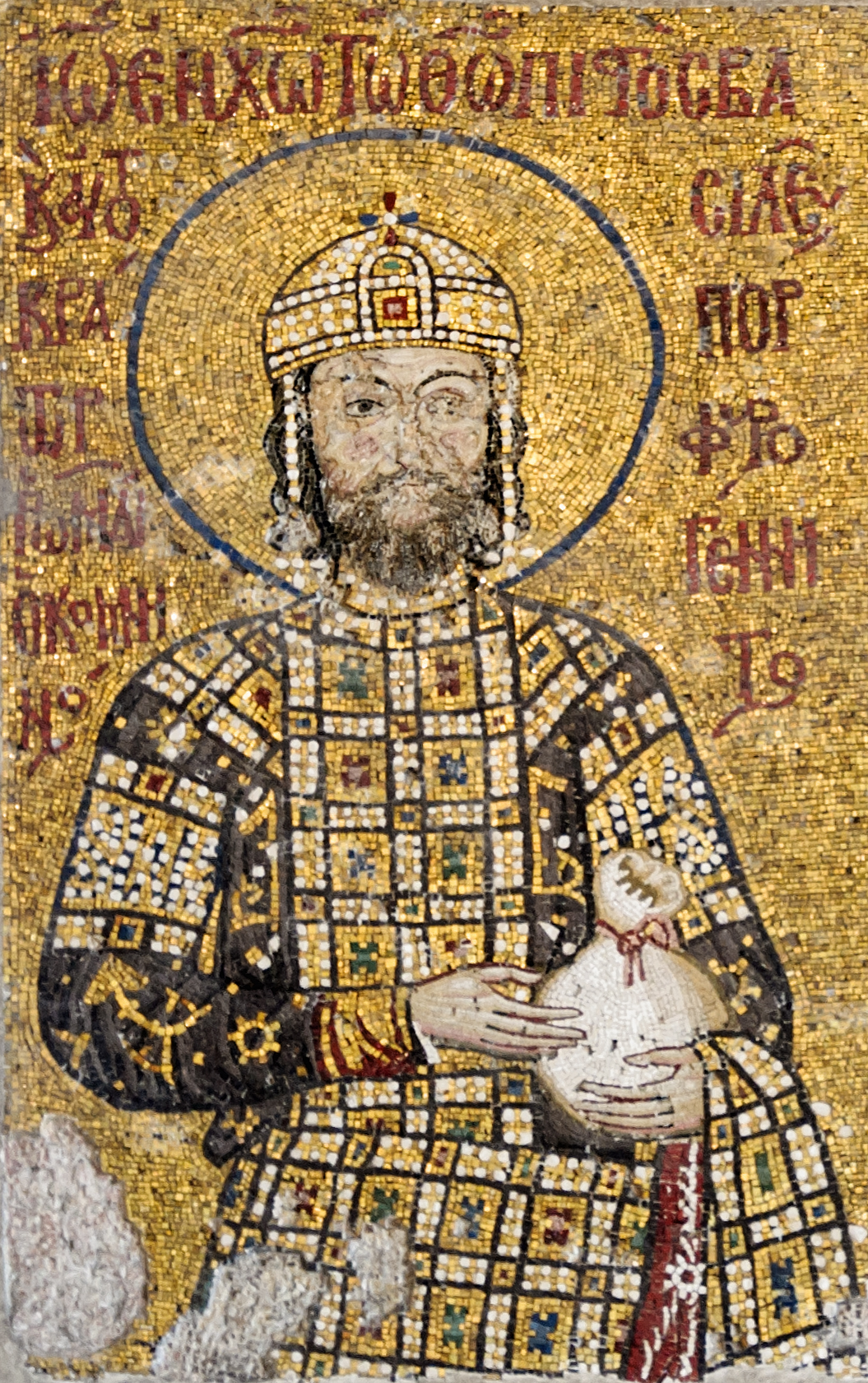
John II - II. Ióannész
Az a császár, aki egyre inkább sokkal jobbnak és érdekesebbnek tűnt – legalábbis a számomra – annál, mint ahogy azt a korábbi szakirodalom sugallta, az II. Theodosius. Már a kései Fergus Miller és Christopher Kelly között is igen erőteljes átértékelés zajlott le II. Theodosiust és uralmát illetően. A Codex Theodosianus, az egyházi zsinatok, a levelek és a consuli listák alapos elemzése döntően felülírták a császárnék szerepének, az irodalomnak. magának a császárnak történeti értelmezését és néhány forrás, mint Szókratész vagy Olümpiodórosz friss perspektívát kapott a hagyományos leírás felülvizsgálatával. A forrásokat illető saját „közeli olvasatommal” egyértelműnek tűnik, hogy távol áll azoktól a róla szóló történetekről, miszerint egy érdektelen egyszerű ember volt, aki almákat adott a feleségének. II. Theodosiusnak aktív szerepe volt a potenciális trónbitorlók leverésében, a nyugati császárt saját jelöltjeivel cserélte ki, érdeklődött az érmék iránt és realisztikusan látta a hunokkal kapcsolatos teendőket. Emellett ő volt a leghosszabb ideig uralkodó római császár az antikvitás óta, még Augustust is felülmúlta császárként való uralkodás tekintetében.
Az utolsó császár, akit meg kell említenem, az III. Niképhorosz, akiről örömmel jelenthetem, hogy volt lehetőségem és lelkesedésem írni valamicskét, ami online publikálásra került. Még mindig van előttem tennivaló, hogy azt mondhassam szakértője vagyok ezen császárnak, mindazonáltal remélem a jelenlegi és folytatólagos kutatásom vele kapcsolatban meglehetősen hasznosnak bizonyulnak és végre betöltenek egy rést a kutatásban, amit régóta vártak és kértek: egy teljes életrajzi tanulmányt III. Niképhoroszról. Ő egy érdekes ember, először a XI. század közepén jelenik meg, hadvezérként ezután számos tartományban vette át a parancsnokságot Antiókhiától a Dunáig és mind ázsiai, mind európai hadszíntereken harcolt. Végül császár lett és kezelnie kellett egy igen nehéz helyzetet ami csak egyre rosszabbá vált, sőt, végül csak uralomra jutása után 14 évvel oldódott meg a helyzet I. Alexiosz uralkodásának második évtizedében. A XI. századot nagyon érdekes időszaknak találtam és évekkel ezelőtt akartam valamit írni róla. Végül III. Niképhoroszra esett a választásom, mert az uralkodása elég rövid volt és eléggé könnyűnek tűnt megcsinálni. Mekkorát tévedtem! De örülök mert az ő élete és uralkodása lenyűgöző és remélhetőleg idővel képes leszek teljes mértékben kifejteni és megosztani mindazt, amit képes leszek találni erről a császárról. Emellett meglehetősen sok forrás van az uralkodásához, mind például egy aranybulla, Szkülitzész történeti írásai, Attaleiatész, Anna Komnéné, Bürenniosz és Zonarasz, ahogy kolostori évkönyvek, érmék, pecsétek és egyéb irodalom, amelyek III. Niképhorosz életét a kutatás számára termékeny talajjá teszik.

Nikephoros III - III. Niképhorosz
The official "trailer" of the Eastern Roman History channel:
Az Eastern Roman History csatorna hivatalos "előzetese":


